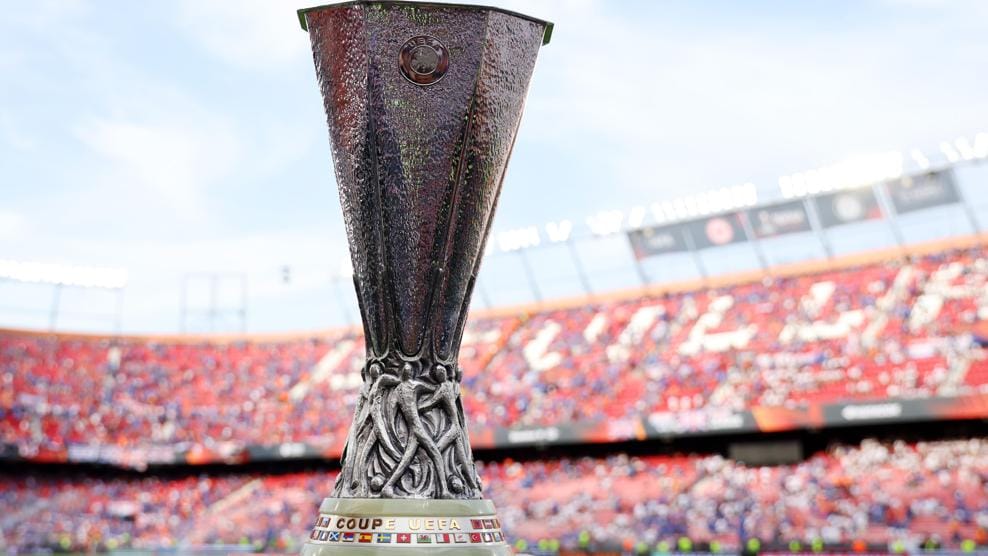The UEFA Europa League Trophy – From Trade Fair Trinket to European Glory
G’day football fans! While most Aussie sports lovers are familiar with the glittering Champions League trophy, there’s another piece of European silverware that’s got quite the story to tell. The UEFA Europa League trophy might be Europe’s “second-tier” prize, but this hefty chunk of silver has witnessed some of the continent’s most dramatic football moments, and recently, it’s had a distinctly Australian flavour.

The Europa League trophy’s story begins not in the boardrooms of UEFA, but in the bustling trade centres of 1950s Europe. Back in 1955, the Inter-Cities Fairs Cup was born – a competition designed to promote commerce between European cities hosting international trade fairs. The original concept was brilliantly bonkers: teams would represent entire cities rather than individual clubs, with players drawn from multiple local sides.
Barcelona claimed the first-ever Fairs Cup in 1958, defeating a London XI that featured players from eight different clubs. The competition ran independently of UEFA until 1971, when European football’s governing body finally took control and rebranded it as the UEFA Cup.
The inaugural UEFA Cup final in 1972 was an all-English affair, with Tottenham Hotspur defeating Wolverhampton Wanderers – a fitting start for what would become one of Europe’s most prestigious competitions.
Unlike its flashier Champions League cousin, the Europa League trophy has maintained a remarkably consistent design philosophy. The original UEFA Cup trophy, crafted for the 1972 final, established the template that endures today: a sleek, handle-free design that prioritises elegance over ornamentation.
The competition underwent its most significant transformation in 2009, when it was rebranded as the UEFA Europa League. This wasn’t just a name change – it represented a complete format overhaul that merged the UEFA Cup with the now-defunct Intertoto Cup, creating the expanded competition we know today.
Today’s Europa League trophy is a genuine heavyweight champion. Tipping the scales at a whopping 15 kilograms, it’s actually the heaviest piece of silverware in UEFA’s collection – heavier than the Champions League trophy. Standing 65 centimetres tall, 33 centimetres wide, and 23 centimetres deep, this is no lightweight trinket.
The trophy’s distinctive design features a silver cup mounted on a yellow marble plinth. Above the base sits an intricate sculptural group that appears to show players battling for possession, but they’re actually supporting an octagonal silver cup emblazoned with the UEFA emblem. The absence of traditional handles gives it a uniquely modern aesthetic that sets it apart from other football trophies.
The magic happens in Milan, where the renowned GDE Bertoni workshop has been crafting the trophy since its inception. This isn’t just any trophy manufacturer – Bertoni is the same company responsible for creating the FIFA World Cup trophy, making them the Rolls-Royce of football silverware production.
Every Europa League trophy is hand-crafted using traditional artisan techniques, with skilled craftsmen spending countless hours perfecting each detail. The company, founded in the early 1900s by Eugenio Losa, has built a reputation for creating some of the world’s most prestigious sporting awards, including the Champions League trophy and UEFA Super Cup.
When it comes to immortalising winners, UEFA keeps things relatively straightforward. Unlike some competitions where engraving happens on-site immediately after victory, Europa League winners’ details are typically added to the trophy in a more controlled environment. The original trophy remains with UEFA at all times, ensuring consistency in the engraving process and maintaining the trophy’s pristine condition.
Trophy Traditions and What Winners Actually Keep
While the original trophy never leaves UEFA’s possession, winning teams receive a full-sized replica that’s identical in every way except ownership. This means clubs can display their prize permanently without worrying about returning it for the next season’s final.
Each winning team also receives 50 gold medals for players and staff, while runners-up take home 50 silver medals. These football medals are distributed not just to players, but to coaching staff and other key personnel who contributed to the campaign.
UEFA has a special recognition system for multiple winners: clubs that win the trophy three consecutive times or five times overall receive a special multiple-winner badge. Only Sevilla has achieved this honour, earning their badge after their fifth triumph in 2020.
Recent Australian Connection
The 2025 final brought the Europa League trophy into Australian sporting consciousness like never before. Ange Postecoglou’s Tottenham Hotspur defeated Manchester United 1-0 in Bilbao, making the former Socceroos boss the first Australian to win a major European club trophy as a manager.
The victory was particularly sweet for Postecoglou, who had famously declared he “always wins things in his second year” – a statement that was widely mocked until Spurs lifted the trophy. The triumph ended Tottenham’s 17-year trophy drought and secured their place in next season’s Champions League.
From Australian glory to administrative blunders, UEFA officials only recently mismanaged the number of medals they actually needed.

UEFA officials embarassingly ran out of medals during the on-pitch ceremony, leaving captain Son Heung-Min and several other players without their silverware during the trophy lift – a bureaucratic blunder that had fans calling UEFA’s organisation “amateurish.”
As European football continues to evolve, the Europa League trophy remains a symbol of continental excellence. With the new Conference League now serving as UEFA’s third tier, the Europa League has solidified its position as a genuine pathway to Champions League qualification and European glory.
For Australian football fans, Postecoglou’s triumph proves that our coaches can compete at the highest level. The UEFA Europa League trophy might not have the same global recognition as the World Cup, but for the clubs and players who lift it, it represents the pinnacle of European achievement – and now, it’s got a distinctly Australian chapter in its storied history.

